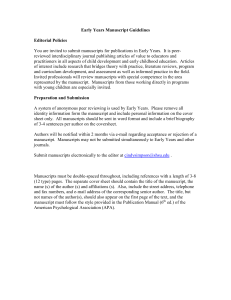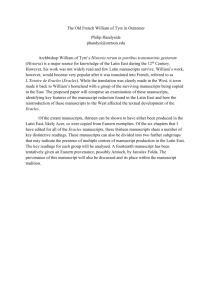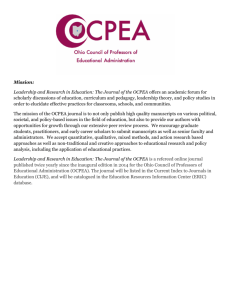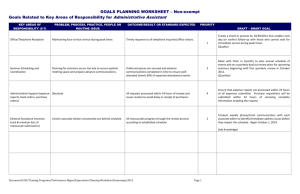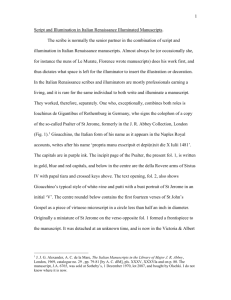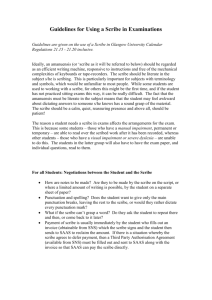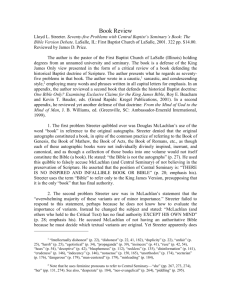Textual criticism
advertisement
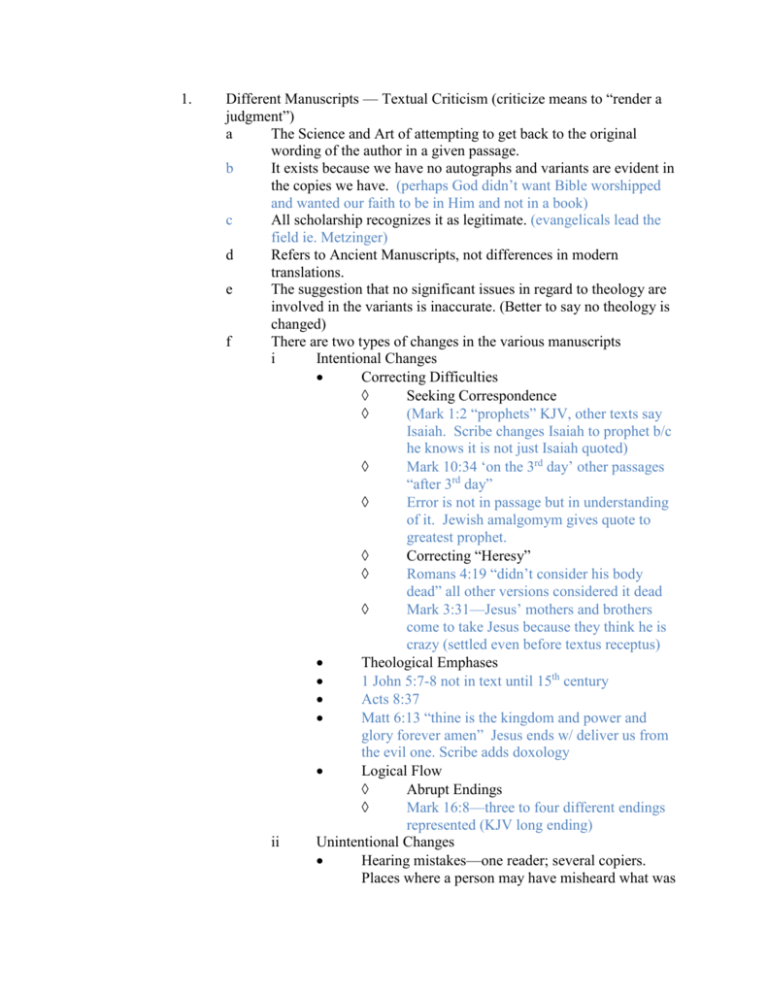
1. Different Manuscripts — Textual Criticism (criticize means to “render a judgment”) a The Science and Art of attempting to get back to the original wording of the author in a given passage. b It exists because we have no autographs and variants are evident in the copies we have. (perhaps God didn’t want Bible worshipped and wanted our faith to be in Him and not in a book) c All scholarship recognizes it as legitimate. (evangelicals lead the field ie. Metzinger) d Refers to Ancient Manuscripts, not differences in modern translations. e The suggestion that no significant issues in regard to theology are involved in the variants is inaccurate. (Better to say no theology is changed) f There are two types of changes in the various manuscripts i Intentional Changes Correcting Difficulties Seeking Correspondence (Mark 1:2 “prophets” KJV, other texts say Isaiah. Scribe changes Isaiah to prophet b/c he knows it is not just Isaiah quoted) Mark 10:34 ‘on the 3rd day’ other passages “after 3rd day” Error is not in passage but in understanding of it. Jewish amalgomym gives quote to greatest prophet. Correcting “Heresy” Romans 4:19 “didn’t consider his body dead” all other versions considered it dead Mark 3:31—Jesus’ mothers and brothers come to take Jesus because they think he is crazy (settled even before textus receptus) Theological Emphases 1 John 5:7-8 not in text until 15th century Acts 8:37 Matt 6:13 “thine is the kingdom and power and glory forever amen” Jesus ends w/ deliver us from the evil one. Scribe adds doxology Logical Flow Abrupt Endings Mark 16:8—three to four different endings represented (KJV long ending) ii Unintentional Changes Hearing mistakes—one reader; several copiers. Places where a person may have misheard what was g said. Vowel combinations sometimes sound identical 1 John 1:4 “that your joy may be full” all others read “our joy may be full Reading Mistakes Skipping a word or line (Haplography—omitting a second word or letter because a word or letter is skipped 1 Thes. 2:7 “we were gentle among you” “we were as children/infants/babes” same letter next to each other Homoeoteleuton-skipping a whole section because of similar words 1 Sam. 10 “now Nahash the ammonite” dead sea scrolls and Josephus both mention this paragraph. Sept. masoretic text no one else mention it. Matt 5:20 Kingdom of heaven 3 times in KJV. Several manuscripts where this caused skips) Mistaking similar letters 1 Tim. 3:16 “God was manifest in the flesh” –“he was manifested” Mistaking Notes in margin for text John 5:3-4 “angel troubling water”—added by a scribe Misdividing Words— Mark 10:40 –for whom it is prepared. “it is prepared for others” Amos 6:12 “do horses run on rocks?” “do you plow with oxen?” yes--. Two problems 1) get a yes answer when it should be no. 2) oxens is not correct. Take ending off and change vowel it changes question to “does one plow the sea with oxen” Writing Mistakes Misspellings Dittography— Jeremiah 51:3 “bend twice in a sentence” broke Hebrew syntactical rules to do so Switching order of letters— Mark 14:65 “hitting w/ palms” or slapping the face Inserting memorized text into material that is similar. Col. 1:14 “in whom we have redemption through his blood, even the redemption of sins” through his blood is prob. a scribe remembering Eph. 1:7 External Evidence i Manuscript Quality-- 1 Original language versus translation—favor Greek manuscript over latin, etc h i 2 Type of Manuscript (order of preferred) Papyrus—doesn’t last long. Wouldn’t be used once church gained wealth Uncial—all words written in uppercase Greek letters—favored b/c it takes time to produce Minuscule—written in cursive. Lower and upper case Lectionary—book of worship which scripture passages are written then commented on w/ church calendar. Helpful bc you would be careful what would be written but selective Patristics—church fathers quoting. Why does he not mention and probably working off of what he remembers ii Earliest Attestation—earlier the better iii Widespread Geographically 100 “Jim ate raisins” all found within a 10 mile radius of Athens 20 “jim ate grapes” 5 in Europe 5 in Asia minor 5 in Africa 5 in Rome. iv Family Type (N.T. only) Alexandrian—centered around upper Egypt Palestine, etc Early Fairly conservative in alterations—they don’t add things—almost always going to be shorter reading Byzantine Most numerous Later in Origin—middle ages Western Early Tends to Expand Internal Evidence i Shorter Reading is Preferred—more likely to add something then take away ii More Difficult Reading is preferred—scribes are more likely to make things clearer then confound them iii Less Harmonistic Reading is preferred iv View that best explains the others is preferred.—this is the big one. Example (Luke 22:17-21) i Reading 1: And he took a cup, and when he had given thanks he said, “Take this, and divide it among yourselves; ii iii for I tell you that from now on I shall not drink of the fruit of the vine until the Kingdom of God comes.” And he took bread and when he had given thanks he broke it and gave it to them saying, “This is my body which is given for you. Do this in remembrance of me.” And likewise the cup after supper, saying, “This cup which is poured out for you is the new covenant of my blood. But behold the hand of him . . . Reading 2: And he took a cup, and when he had given thanks he said, “Take this, and divide it among yourselves; for I tell you that from now on I shall not drink of the fruit of the vine until the Kingdom of God comes.” And he took bread and when he had given thanks he broke it and gave it to them saying, “This is my body.” But behold the hand of him . . . Factors Both Readings are the same in age Reading 1 has Alexandrian and Byzantine Support Reading 2 is the Western text, but goes against Western Tendencies Reading 2 is the shorter text. Both have difficulties and are not harmonious Reading 1 has two cups Reading 2 has the cup first j Issue settled by which explains the other best. One can see how one might get from reading 1 to reading 2 Hard to see how one gets from 2 to 1. Text 2 is apparently an attempt to move the second cup in Passover meals for theological reasons. Text 1 explains the presence of text 2, but text 2 cannot explain text 1. Steps in the Process for “Non-Experts” i Look for annotations in an annotated edition. ii Identify the type of problem. (a category the change would fit into) iii Consult a critical commentary. International critical commentary. Word commentary iv List the evidence. (sometimes a wash sometimes not even close) v Make a Choice.

